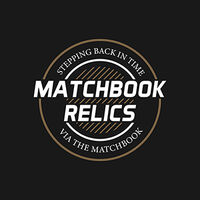In the mid-20th century, labor unions sought innovative and effective methods to promote their causes, engage with members, and garner public support. One such method was the use of vintage matchbooks. These small, practical items served as powerful tools for spreading messages, rallying support, and reinforcing union solidarity. This article explores how labor unions ingeniously utilized matchbooks to promote their organizations and activities.
Matchbooks as Miniature Billboards
Matchbooks functioned as portable billboards, perfect for conveying the core messages of labor unions. The covers of these matchbooks often featured the union’s name, logo, and motto, along with contact information and meeting details. Slogans such as "Strength in Unity," "Support Your Union," and "Fair Wages for All" were prominently displayed to rally support and communicate the union's mission. By using bold and eye-catching designs, unions ensured that their messages stood out and resonated with members and the broader community.
Strategic Distribution for Maximum Impact
Labor unions distributed matchbooks strategically to maximize their impact. These matchbooks were handed out at union meetings, rallies, and labor strikes, ensuring they reached a wide audience of members and supporters. Additionally, they were placed in local businesses, cafes, and community centers, where workers and community members frequently gathered. This wide distribution helped maintain a visible presence in the daily lives of workers, reinforcing the union's presence and message.
Promoting Union Meetings and Events
Matchbooks were also used to promote union meetings, events, and initiatives. They often included information about upcoming rallies, protests, and educational workshops, encouraging members to participate and stay engaged. By providing details about time, location, and agenda on the matchbook covers, unions made it easy for members to stay informed and involved. This constant reminder helped boost attendance at events and foster a sense of community and solidarity among union members.
Educational Outreach and Advocacy
Labor unions used matchbooks as educational tools to advocate for workers' rights and raise awareness about key issues. Matchbooks often featured brief but powerful messages about workers' rights, labor laws, and the benefits of union membership. For example, they might include tips on how to handle workplace disputes, information about collective bargaining, or reminders of important labor rights. This educational outreach helped empower workers with knowledge and encouraged them to support the union’s efforts.
Building a Sense of Unity and Solidarity
The use of matchbooks helped labor unions build a sense of unity and solidarity among their members. The shared experience of carrying and using these matchbooks fostered a sense of belonging and common purpose. Union-themed matchbooks often featured images of workers standing together, clasped hands, or symbols of strength and unity, reinforcing the idea that members were part of a larger collective movement. This sense of unity was crucial for maintaining morale and encouraging active participation in union activities.
Creating Lasting Impressions
Matchbooks were not just temporary advertisements; they created lasting impressions. The practical nature of matchbooks meant they were frequently used and kept in easily accessible places, such as pockets, toolboxes, and kitchen drawers. This frequent interaction helped keep the union’s message top-of-mind and ensured that the union’s presence was always felt. Moreover, the nostalgic charm of these vintage matchbooks made them cherished keepsakes, further extending their reach and impact.
Adapting to Modern Times
While the use of matchbooks as promotional tools has diminished with the rise of digital media, the legacy of their effectiveness remains. Labor unions today continue to seek innovative ways to connect with members and promote their causes, using modern technologies while drawing inspiration from past strategies like matchbook advertising. The principles of visibility, engagement, and unity that matchbooks embodied still guide union outreach efforts in the contemporary era.
Conclusion
The use of vintage matchbooks by labor unions was a strategic and effective way to promote their causes and engage with members. By turning these everyday items into powerful promotional tools, unions ensured their messages were visible, accessible, and memorable. The practical utility and frequent handling of matchbooks helped build union solidarity, foster community support, and enhance the overall visibility of labor movements. Today, these vintage matchbooks serve as nostalgic reminders of an innovative era in union promotion, illustrating the creative ways in which labor unions connected with workers and advocated for their rights.
